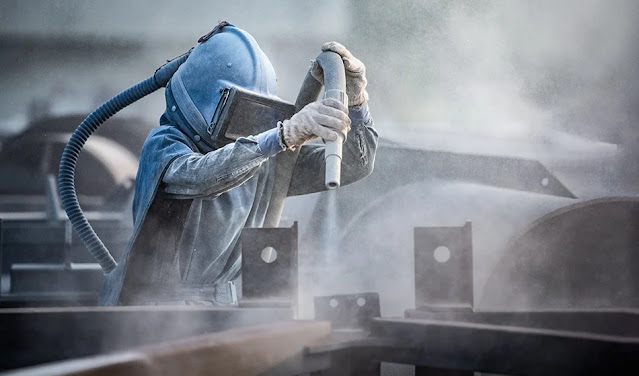Abrasive Blasting Safety
Ensuring Safety at Heights in Industry
Abrasive blasting is one of the high risk activities because various HSE Hazards, the following information’s and controls will help you mitigate the risks.
Hazards
Ø Abrasive
blasting work creates very high levels of dust.
Ø The
dust may contain respirable crystalline silica (RCS).
Ø Breathing
this dust can cause serious lung diseases like silicosis, chronic obstructive
pulmonary disease (COPD) and even lung cancer.
Ø These
diseases cause everlasting disability and early death.
Ø The
substance being worked on may contain other hazardous substances, eg lead.
Ø Skin
contact with dusts and prolonged or frequent contact with water may cause dermatitis.
Ø A
good standard of control is needed because the risk to health is high.
Respiratory Protective Equipment (RPE)
ü Provide
the shot blaster with an air-fed ‘CE’ marked abrasive blasting helmet with a Standard
Assigned Protection Factor (APF) of at least 40.
ü Air
supplied to the blasting helmet should be breathing quality.
ü Position
airlines so that they are not liable to be blocked or damaged by moving
vehicles etc.
ü Change
blasting helmet visors as soon as pitting or frosting occurs.
ü Provide
Respiratory Protective Equipment (RPE) with an APF of at least 20 for the
‘kettle man’ working nearby.
ü Fit
testing is ensured for Respiratory Protective Equipment (RPE) with a tight
fitting face seal.
ü Employees
wearing tight fitting Respiratory Protective Equipment (RPE) should be clean
shaven, fully trained in detailed as how to fit it properly and how to look
after it.
Inform employees to discard disposable Respiratory Protective Equipment (RPE) at the end of the shift, or sooner if their RPE becomes blocked with dust.
Chemicals Hazards, Storage & Protection
ü Have
a track and Change the filters on respirators in accordance with manufacturers’
recommendations and if:
v the
shelf-life expiry date has passed;
v they
are damaged or visibly contaminated; or
v they
become harder to breathe through.
ü Inspect
and test non-disposable Respiratory Protective Equipment (RPE) and air supply
thoroughly at least once every month.
ü Inform
Employees to check RPE is working properly before every use.
ü If
the RPE worn by the kettle man is required for extended periods, eg longer than
1 hour continuously, use powered respirators.
ü Always Keep RPE clean and store it in a clean place.
Safety Training Videos with Pictorial Guidelines
Personal Protective Equipment (PPE)
Ø Employees
to wear blasting suits/coveralls that do not retain dust and protect against
water.
Ø Provide
protective gloves and footwear to the employees.
Ø Provide
the storage facility to employee for PPE to prevent damage or contamination
when not in use.
Ø Inform
employees Keep any PPE cleaned and replace at recommended intervals.
Ø Engage contract laundry or a suitable equivalent to wash work clothing. Don’t allow employees to do this at home.
Steam Hazards and Safety Requirements

No comments:
Post a Comment